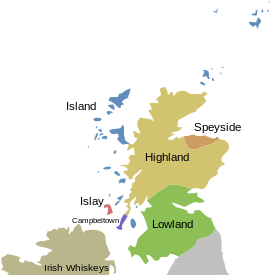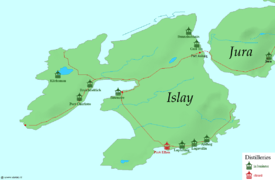Islay whisky


Islay whisky is Scotch whisky made on Islay (/ˈaɪlə/ EYE-lə) or Ìle in Gaelic, one of the southernmost of the Inner Hebridean Islands located off the west coast of Scotland. Islay is one of five whisky distilling localities and regions in Scotland whose identity is protected by law.[1] There are eight active distilleries and the industry is the island's second largest employer after agriculture.[2][3] Islay is a centre of "whisky tourism", and hosts a "Festival of Malt and Music" known as Fèis Ìle each year at the end of May, with events and tastings celebrating the cultural heritage of the island.
Styles of whisky
The whiskies of the distilleries along the southeastern coast of the island, Laphroaig, Lagavulin, and Ardbeg, have a smoky character derived from peat, considered a central characteristic of the Islay malts, and ascribed both to the water from which the whisky is made and to the peating levels of the barley. Many describe this as a "medicinal" flavour. They also possess notes of iodine, seaweed and salt.[4] Caol Ila, on the northern side of the island, across from Jura, also produces a strongly peated whisky.
The other distilleries on the island make whisky in a variety of styles. Bunnahabhain makes much lighter whiskies which are generally lightly peated. Bowmore produces a whisky which is well balanced, using a medium-strong peating level (25 ppm) but also using sherry-cask maturation. The newest distillery, Kilchoman, started production in late 2005. In location it is unlike the other seven distilleries, which are all by the sea.
Distilleries
Active distilleries
| Distillery | Pronunciation | Meaning | Years active | Location | Notes |
|---|---|---|---|---|---|
| Ardbeg | /ɑːrdˈbɛɡ/ ard-BEG | small headland | 1815–1981, 1990–1996, 1997– | 5 km east of Port Ellen | owned by Glenmorangie, / LVMH |
| Bowmore | /boʊˈmɔːr/ boh-MOR | great sea reef or sea rock | 1779– | in Bowmore, the island's capital | owned by Beam Suntory, sells 7-year-old malt under the McClelland's brand |
| Bruichladdich | /brʊkˈlædi/ bruuk-LA-dee | bank on the shore | 1881–1995,‡ 2001– | on western Loch Indaal, across from Bowmore | reopened as an independent distillery; Purchased in 2012 by Remy Cointreau[5] |
| Bunnahabhain | /ˌbuːnəˈhævən/ BOO-nə-HA-vən | mouth of the river | 1880/1883– | 4 km north of Port Askaig | owned by Burn Stewart, a notable part of the Black Bottle blend |
| Caol Ila | /kʊlˈaɪlə/ kuul-EE-lə | The Sound of Islay (between Islay & Jura) | 1846–1972,‡ 1974– | 1 km north of Port Askaig | owned by Diageo |
| Kilchoman | /kiːlˈtʃoʊmən/ keel-CHOH-mən | St. Comman's church | 2005– | on the Atlantic coast | first all new distillery since 1881 |
| Lagavulin | /ˌlɑːkəˈvuːlɪn/ LAH-kə-VOO-lin | the hollow where the mill is | 1742/1816– | 4 km east of Port Ellen | owned by Diageo |
| Laphroaig | /ləˈfrɔɪɡ/ lə-FROYG | beautiful hollow by the broad bay | 1815– | 2 km east of Port Ellen | owned by Beam Suntory |
Closed distilleries

The oldest record of a legal distillery on the island of Islay refers to Bowmore in 1779 and at one time there were up to 23 distilleries in operation.[6] For example, Port Charlotte distillery operated from 1829 to 1929[7] and Port Ellen is also closed although it remains in business as a malthouse[6] that supplies many of the Islay distilleries.
In March 2007 Bruichladdich Distillery announced the reopening of the distillery at Port Charlotte (Port Sgioba in Gaelic), which was closed in 1929, and was also known as the Lochindaal distillery.
- Achenvoir (pre-1816–1818+), in Argyll
- Ardenistle (1837–1849) / Kildalton (1849–1852) / Islay (1852–1852), subsumed by Laphroaig 1853
- Ardmore (1817–1835), taken over by Lagavulin 1837
- Daill (1814–1830), ruins on road between Port Askaig & Bridgend
- Freeport (1847–1847), location unknown
- Hazelburn (1825–?), uncertain relation to the Hazelburn distillery of Campbeltown
- Kildalton (1817–1837), merged with Lagavulin
- Killarow (c.1760–1818) / Bridgend (1818–1822), ruins in village
- Lochindaal/Port Charlotte/Rhinns (1829–1929), near BruichLaddich
- Lossit (1821) / Ballygrant (1826–1860), ruins south of the village A846
- Malt Mill (1908–1962), now part of Lagavulin[8]
- Mulindry (1826–1827), at the junction of the Neriby Burn and the River Laggan, now in ruins[8]
- Newton (1819–1837), ruins immediately south of A846 between Port Askaig & Bridgend[8]
- Octomore (1816–1852), ruins near Port Charlotte
- Port Ellen (1825–1929, 1967–1983), large port village of Islay, converted to a malting[6][8]
- Scarabus (1817–1818), no evidence of production
- Tallant (1821–1852), Tallant farm south of Bowmore
- Torrylin (?–?), may have been on the Isle of Arran
Notes
- ↑ "The Scotch Whisky Regulations 2009". The National Archives. Retrieved 22 April 2012.
- ↑ Newton (1995) p. 32
- ↑ "Whisky Regions & Tours". Scotch Whisky Association. Retrieved 22 April 2012.
- ↑ Jackson, Michael, Michael Jackson's Complete Guide To Single Malt Scotch, (Running Press Book Publishers, 2004), 48.
- ↑ "Remy Cointreau to buy Scotland's Bruichladdich". Wall Street Journal. Retrieved 26 July 2012.
- 1 2 3 Newton (1995) p. 33
- ↑ "Port Charlotte Distillery". IslayInfo. Retrieved 22 April 2012.
- 1 2 3 4 "Islay's "lost" Whisky Distilleries". Islayinfo.com. Retrieved 1 December 2012.
References
- Newton, Norman (1995) Islay. Devon. David & Charles PLC. ISBN 0-907115-90-X
External links
- Islay Whisky Society
- Argyll Tourist Board
- Google Earth placemark with Islay distilleries
- The Islay Whisky Chapter Austria